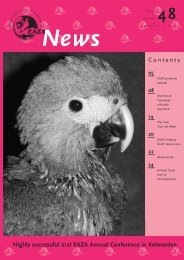EAZA Tiger Campaign extended to 2004 Contents - European ...
EAZA Tiger Campaign extended to 2004 Contents - European ...
EAZA Tiger Campaign extended to 2004 Contents - European ...
You also want an ePaper? Increase the reach of your titles
YUMPU automatically turns print PDFs into web optimized ePapers that Google loves.
As this information is necessary for<br />
management decisions, the TAG decided<br />
<strong>to</strong> establish, update and computerise<br />
studbooks for all potential candidates <strong>to</strong><br />
be kept in <strong>European</strong> zoos in the future<br />
as listed in Table 1.<br />
In the past inappropriate captive<br />
environments were blamed for many<br />
behavioural problems in ursids. Thus, <strong>to</strong><br />
meet the second goal, conditions had<br />
<strong>to</strong> be improved so that captive bears<br />
develop in<strong>to</strong> appropriate behavioural<br />
and morphological representatives of<br />
their wild conspecifics. Consequently<br />
husbandry guidelines, with recommendations,<br />
were written. These guidelines<br />
were based on good practice in zoos,<br />
on information extracted from husbandry<br />
surveys and on conclusions<br />
drawn from published work on bear<br />
biology in the field. The English version<br />
was translated in<strong>to</strong> several languages<br />
<strong>to</strong> facilitate its distribution and use in<br />
<strong>EAZA</strong> range countries (see Table 1).<br />
Collection plan<br />
The <strong>EAZA</strong> Bear TAG includes seven<br />
bear species, none of which is under<br />
immediate threat or in need of ex situ<br />
breeding <strong>to</strong> prevent extinction at<br />
species-level. Currently zoos in the range<br />
countries are refuges for confiscated<br />
bears, illegally removed from the wild<br />
or for bear cubs orphaned during legal<br />
hunting sessions. Nevertheless illegal<br />
hunting plus habitat degradation pose<br />
real risks for the long-term survival of<br />
ursids. Consequently, spreading information<br />
on bear behaviour and habitat<br />
needs is most important. The TAG<br />
survey of <strong>EAZA</strong> members indicated<br />
that brown bears (Ursus arc<strong>to</strong>s) constitute<br />
40% of the captive <strong>European</strong> bear<br />
population and have a high educational<br />
value, particularly where the species<br />
occurs naturally (in the majority of<br />
<strong>EAZA</strong> range countries). This led <strong>to</strong> the<br />
Collection Planning<br />
TAG recommendation that most of the<br />
spaces available in Europe be reserved<br />
for native species and populations: brown<br />
bears, polar bears (Ursus maritimus)<br />
and the Asiatic black bear of the<br />
Russian Far East (Ursus thibetanus<br />
ussuricus). It was concluded that only<br />
relatively small populations of the tropical<br />
bear species should be maintained<br />
and that it was crucial <strong>to</strong> maintain<br />
close cooperation with zoos in range<br />
countries or managed programmes in<br />
other regions (AZA) <strong>to</strong> preserve genetic<br />
diversity in these species.<br />
The combined studbook data indicated<br />
that approximately 1000 bears were<br />
living in approximately 250 enclosures<br />
in about 150 locations distributed over<br />
more than 20 <strong>EAZA</strong> range countries.<br />
When minimum enclosure standards we<br />
had set were integrated in<strong>to</strong> the collection<br />
planning process we concluded<br />
that only half of the enclosures were<br />
suitable for breeding or keeping more<br />
than one or two animals.<br />
The next steps<br />
The <strong>EAZA</strong> Regional Collection Plan for<br />
bears will soon be published, and then<br />
implemented. Information gained over<br />
the past years in conferences and workshops<br />
with bear conservationists (see<br />
Table 1) indicates that bears in <strong>EAZA</strong><br />
zoos will not be needed for reinforcement<br />
of wild populations in the near future.<br />
Research and long term moni<strong>to</strong>ring of<br />
released wild-born orphans should first<br />
be undertaken. Conservation education<br />
based on captive bears will have far<br />
higher priority during the next few<br />
years. Consequently, the TAG needs <strong>to</strong><br />
develop and spread its messages on the<br />
in situ situation, on the one hand, and<br />
on the other hand, needs <strong>to</strong> stimulate<br />
even more improvement of the captive<br />
environment; <strong>to</strong> close the gap between<br />
the number of appropriate spaces and<br />
the number of bears. In order <strong>to</strong> achieve<br />
EEP committee<br />
The following new EEPs, ESBs,<br />
new EEP coordina<strong>to</strong>rs and <strong>European</strong><br />
studbook keepers were approved:<br />
NEW PROGRAMMES<br />
BLACK MARSH TURTLE ESB<br />
(Siebenrockiella crassicollis)<br />
Mr. Aleksander Niwelinski, Plock Zoo<br />
MALAYAN BOX TURTLE ESB<br />
(Cuora amboinensis)<br />
Mr. Aleksander Niwelinski, Plock Zoo<br />
BANK CORMORANT EEP<br />
(Phalocrocorax neglectus)<br />
Mr. Bart Hiddinga, NFRZG, Amsterdam<br />
LIVINGSTONE’S FRUITBAT ESB<br />
(Pteropus livings<strong>to</strong>ni)<br />
Downgraded from EEP with coordina<strong>to</strong>r<br />
Dominic Wormell, Jersey, <strong>to</strong> ESB with<br />
coordina<strong>to</strong>r Mr. Will Masefield, Jersey Zoo<br />
NUBIAN IBEX ESB<br />
(Capra nubiana)<br />
Mr. Hanakova Lenka, Bratislava Zoo<br />
NEW STUDBOOK KEEPERS<br />
TURKMENIAN MARKHOR ESB<br />
(Capra falconeri heptneri)<br />
Ms. Paula Holma, Helsinki Zoo<br />
these goals the TAG will facilitate and<br />
intensify contacts within the zoos and<br />
between zoos and the field researchers<br />
and conservationists.<br />
New TAG chair<br />
Lydia Kolter thanks the <strong>EAZA</strong> Bear<br />
TAG members for their excellent<br />
cooperation, support and cohesion<br />
over critical questions during the past<br />
ten years. She will pass the position<br />
of the Bear TAG chair <strong>to</strong> José Kok.<br />
José was pre-destined <strong>to</strong> undertake<br />
the tasks <strong>to</strong> come, for several reasons:<br />
her background is as an educa<strong>to</strong>r; for<br />
two years she has been the <strong>European</strong><br />
brown bear studbook keeper and she<br />
works in the Department of Biology<br />
and Education at Ouwehands Dierenpark,<br />
Rhenen, the Netherlands with its<br />
exemplary new enclosures for bears.<br />
<strong>EAZA</strong> News 43 – 2003<br />
27<br />
July - August - September

















